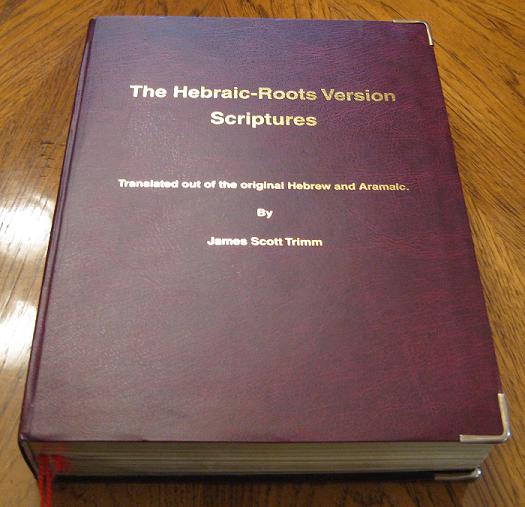

Rating
Price and Value
Scroll down to the bottom for pictures!
Summary of Features
Feature
Publication Date
1st Edition: 2004
Cover
Bonded Leather
Size
11.25 inches tall
8.4 inches long
1.9 inches thick
Binding
Smyth-Sewn
Thumb-Index Tabs
No
Text Format
Single Column Verse Format
Headings
None
Mashiyach's Words in Red
No
Number of Ribbon Markers
One
Gold Gilded w/ Rounded Corners
Gold Gilded, Square Corners
Extensive Cross References
No
Helps
50 Page Introduction
Torah/Haftarah Chart
Parable Charts
Illustrations
Maps
Footnotes
Alternative Manuscript Readings
Basic Cross References
(299 in Tanak, 1770 in Ketuvim Netzarim)
Concordance
No
Maps
6 Maps
Name of the Father
YHWH
Name of the Son
Yeshua
Hebrew Transliterations
Names and Places
Book Order
Hebrew Tanak Order
Torah
Prophets
Writings
Eastern Aramaic Order
Good News/Acts
Jewish Epistles
Pauline Epistles
Revelation
Base Text
1917 JPS Tanak
The Way International Aramaic/English Interlinear
Old Archaic English
No
Manuscript Origin
Hebrew Masoretic Text(primary)
Peshitta Tanak (consulted)
Greek Septuigant (consulted)
Dead Sea Scrolls (consulted)
Aramaic Targums (consulted)
Samaritan Pentateuch (consulted)
Peshitta New Testament (primary)
Old Syriac Gospels (primary consultant)
Dutillet, Munster and Shem Tob Matthew (primary/consulted)
Munster Hebrews (primary)
Crawford Revelation Manuscript (primary)
Codex Khabouris (consulted)
Updated Review
NOTE - I originally wrote a review for this when my knowledge of the original languages and texts was very low and my Hebraic theology was also elementary in comparison to now. I also was writing the review for the sake of having a review as opposed to me actually wanting to review the product. Therefore I have re-done my entire review below. The old review can still be read here.
I know this translation is not very popular or spoken about much anymore, but just in case there are still a few inquiring people, I thought it would be important to give fair warning. Keep in mind that I read and teach Hebrew and have spent a considerable amount of time discussing Aramaic primacy with several scholars, so this is not new or foreign territory for me.
First, this is a patchwork of a translation based on so many sources that you are reading something that has never before existed prior to this publication, nor are the consulted sources even translated correctly at times. There is no single manuscript that will read like the books of Trimm's New Testament (or Tanakh), therefore you are reading the New testament according to James Trimm and not according to the manuscript record. While critical editions have their value, you are trusting only one man who in the majority of cases goes against most (if not all) other scholars.
We have several issues here to discuss.
1) Use of the DuTillet Hebrew Matthew (edited as he sees fit).
The DuTillet Hebrew Matthew, as well as the Munster and Shem Tob are easily proven to be revisions from a Greek manuscript and not in anyway original. There are no other manuscripts that line up with their unique and blatantly dubious readings, and all of these manuscripts are AT LEAST 1000 years older than our oldest Aramaic and Greek manuscripts. Further, we have no single recording or quote from any church founder for readings supported in the Hebrew Matthews. Origin, Jerome, and Eusebius had access to the Nazarene writings, including the "Gospel according to the Hebrews" and, in listing variations from their texts, not once do they mention any reading of which you find in Shem Tob, DuTillet or Munster. If you're wondering about word plays, the only reason you have Hebrew word plays is because in the Greek NT you have either a recording or translation of Aramaic speech which would have had these same word plays in them already. But if you are an Aramaic primacist, you know that there were mistranslations from Aramaic into Greek and it is these mistranslations which also exist in these Hebrew Matthew's. So any translator (or in this case, editor) who is trusting these manuscripts as a valid source of textual readings should be a huge red flag from the perspective of honest scholarship.
2) Use of the "Old Syriac" Gospels (molded into a Pesh'tta base because we only have fragments of it).
3) Plagiarized Peshitta base from the Way's Aramaic English Interlinear NT.
4) The actual background and credentials of who you're trusting to deliver to you the Word of our Elohim and Good News of our Mashiach
Second, the Old Syriac; sometimes called the "Old Scratch" because some of it's copies were scratched off and written over; in other words, it was not treated as Sacred Writings. The Old Syriac does not old any weight over the Peshitta and this has been proven many times from every scholar in the Aramaic community. to see this for yourself, please read the following,
Article 1
Out of those who hold to Aramaic primacy, only one scholar (Joe Veil) takes the Old Syriac into account for a textual critical approach to the Scriptures. This does not mean however that he thinks it is original, he only views it as another ancient witness to use in creating a critical text rather than relying solely on the Peshitta (whether that be the eastern or western Peshitta).
Scholarely Discussion 1
Scholarely Discussion 2
Scholarely Discussion 3
Third, Trimm plagiarized the Way's Aramaic interlinear because he has little knowledge of the languages himself and so needed to use someone else's work. This plagiarism has been proven without a shadow of a doubt many times, and the best compilation can be found on Leb Tahor's website if you are interested (click here). The matter was actually taken to court, and although The Way didn't want to take it to trial (think of all the time and money) the defense presented by Trimm is basically a rehash of his introduction which in many cases is simply a copy of the common arguments you see Paul Younan, George Lamsa, Andrew Roth and several others put forward. Therefore, his defense in many ways is also not original and simply a re-hash of what other scholars teach. This dishonesty is so disheartening and does not bode well for the Nazarene movement at all. I feel uncomfortable saying such on a public forum, but the proper manner for addressing it according to Torah has been done many times in the past and there is no choice but to speak openly. So, after copying, Trimm then edited the text as he saw fit for his own ideas. Both the Way's interlinear and Trimm's edit contain a doctrinal bias that would take too long to dissect and correct though. So even if you are a student of the original languages you would be better off investing in something else altogether unless Trimm had included the actual original texts on the opposing page so you could practice your language skills and translate for yourself.
Finally, it may be wise to investigate the background, credentials, and behaviour of who you are trusting to deliver the Word of Elohim to you. This is not relevant to the product however so I will leave that to you.
As far as the Tanakh goes, it is a lightly edited version of the JPS 1917 from the public domain. Some of the archaic language has been updated, but not all of it. Some awkward sentence structuring and such remains. All names have been transliterated into their Hebrew equivalents, but the shewa-holem (e-o) in some names has been altered to a qamats-shureq (a-u) without any valid reasoning. There is some dubious theory circulating about the vowels in names that has never been proven nor taught by any scholar who actually knows the languages with sufficient proficiency. Vocal shewa's are also transliterated with an ' instead of an e. Tanakh is also spelt Tanak, even though the final letter is a soft pronunciation of the word (in other words, it should be Tanakh / Tanach). Other poor scholarship is the claim that Y-H-W-H in the Masoretic text had the vowels for Eloah inserted into it. Although this may seem so in English, if you can actually read Hebrew, you would clearly notice that they are not. Eloah carries the vowels composite segol-holem-patach, where as the Divine Name (as writtein in Trimm's introduction) carries the vowels shewa-holam-qamats. I hate to say it, but if Trimm were not a pseudo-scholar he would know this. Trimm also promises extensive textual criticism in the Tanakh when there is actually very little provided. You have a little over 200 notes in the Tanakh with over 134 of them being references to the possibility of the Masorites having changed Y-H-W-H to Adonai. So you are left with very little additional insight into the manuscript record. You would be better off getting the DSS Bible which has tons, or learning the languages yourselves and picking up a BHS.
The book itself is big, bulky, and awkward. The print is not always good and it is single column verse format which is not enjoyable to read nor aesthetically pleasing.
So, in conclusion, if you are looking for a scholarly translation of the Aramaic with textual notes, I would recommend anything but this volume. Janet Magiera has a translation available that has almost no bias and is something I am confident telling you that you can trust (this is based on my own translation work). Her regular volume contains many textual variants which will make up for what you would miss in this volume. She has also even released a Messianic Version so you can read the Semitic forms of people and places. But if you are looking for a Nazarene/Netzari/Natsari bible, then Andrew Gabriel Roth's has produced a much better version which should suit your purposes far better than this volume. Not only did he do a much better job, he has a much higher working knowledge of the languages, is a lot more honest, and has included A LOT of Nazarene commentary that one seeking this kind of a bible would appreciate (it is a theological gold mine for Netzarim).
I hope that anyone investigating these different bibles has found this review helpful and edifying.
Pictures
Click on an image for a bigger picture

The cover is fairly plain with a standard font that doesn't really jump out at you. If you're wondering about the string, I attached it to the ribbon marker that's too short and frayed to actually stick out anymore. Notice the brass edges on the corners. This is a nice touch!
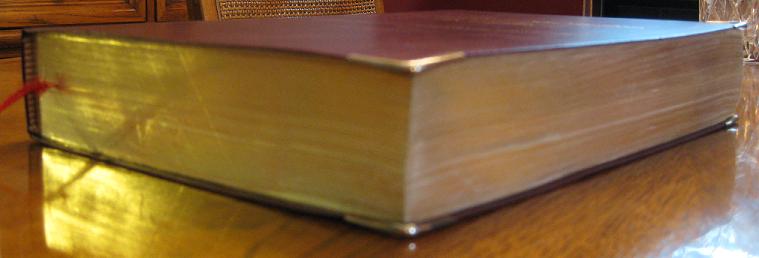
Here you can see the gold gilded pages and square corners.

The spine. Standard lettering again.
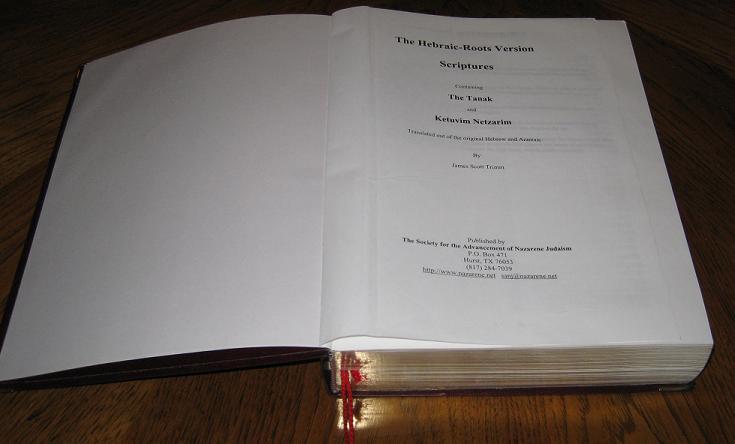
As mentioned, the book opens up slat right from the very first page! This is a huge change from the NT only that had to be pried open with the fingers. It's too bad that this one is way too big to actually hold in the hand.
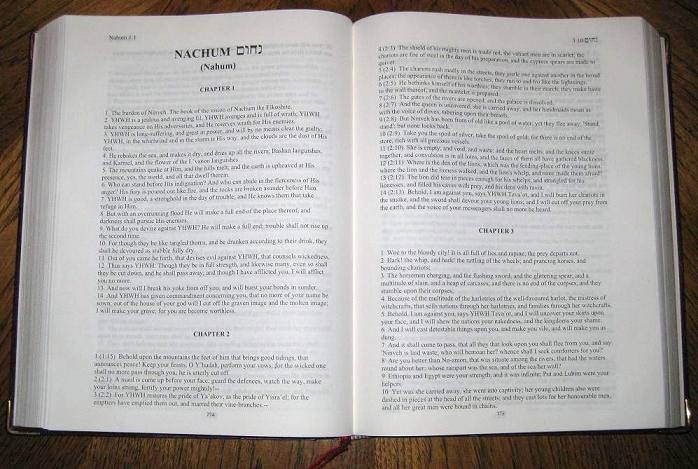
Here it is flat. As you can see, there is quite a bit of bleed through. Notice the wide margins for note taking.

Here you can see what the ribbon marker is like. Notice the single column verse format. You can also see some of the bleed through from way back here.
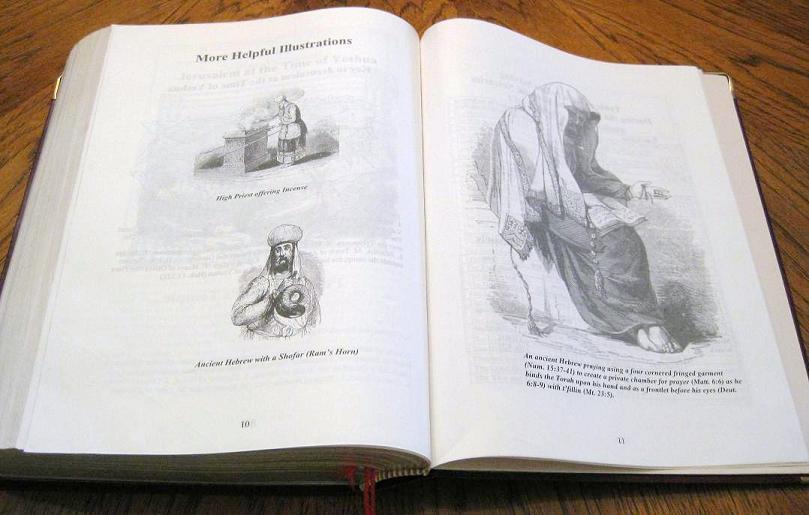
Here is an example of some of the illustrations.

And here's a sample of the maps, just so you have an idea of what I mean when I said "cheap".
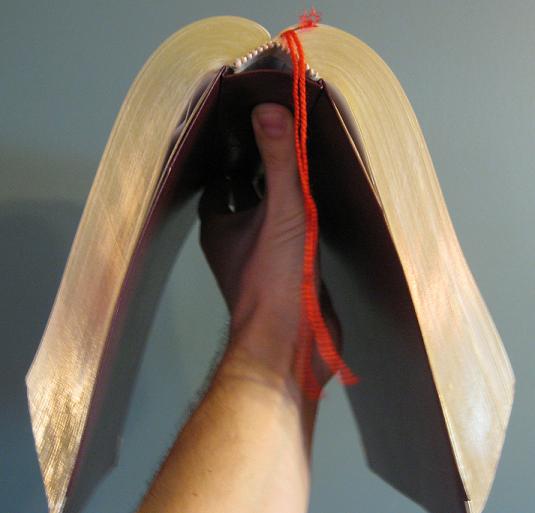
Obviously this droops no problem.
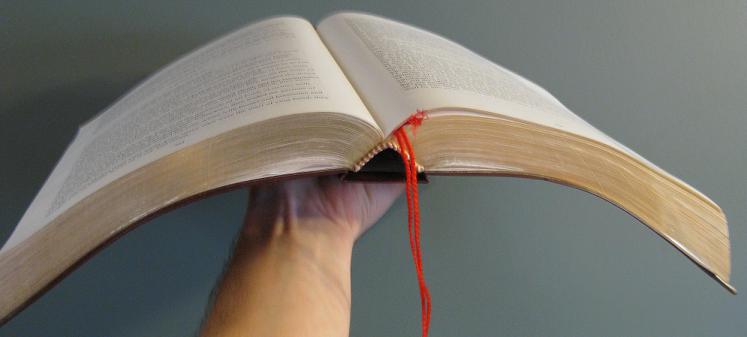
However here you can see just how gigantic this is, and how you wouldn't hold it in the hand. Notice also how it's not hardcover, yet it's not really a soft cover bonded leather either. Somewhere in between.
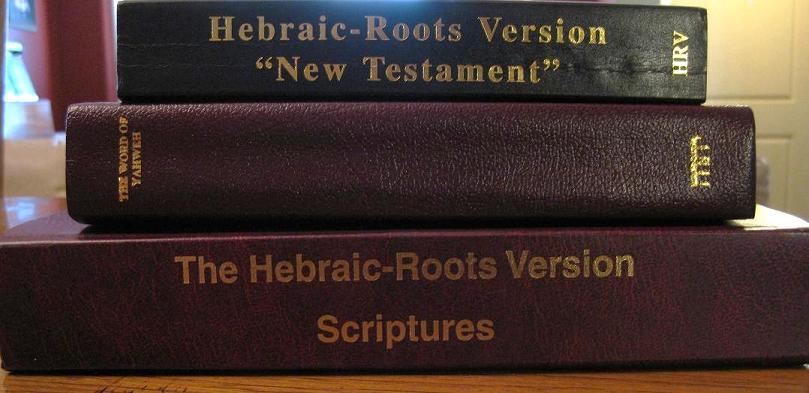
Compared to other versions available, you can see just how big this is.
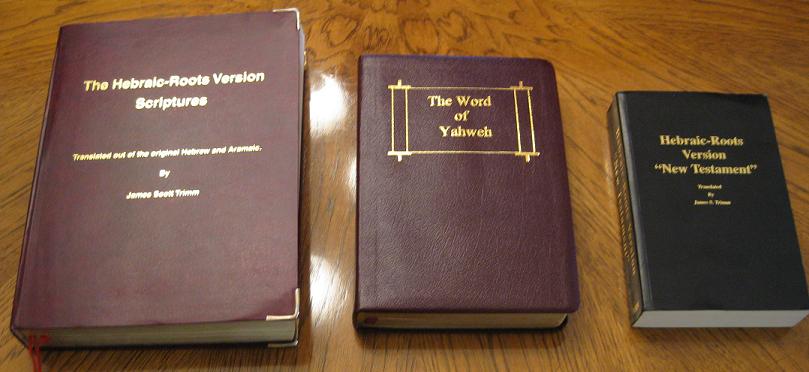
Another shot showing how large this is.
As I'm finishing up this review, I feel compelled to say something. Though I have said much here, I want to emphasize just how blessed we are to live in an age where we have such access to the Word of Elohim. And even today, there are countries where the Word must be smuggled in. So while I am here writing critical reviews of various versions of the Scriptures, I want to remind us all that we should be very, very thankful for what we have. More over, we should learn from the Word and apply it in our lives in such a way that we can bring joy to everyone we encounter. I pray that we would all be a light to the world, provoking Israel to jealousy and bringing the Good News of Salvation (Yeshua!) and the Kingdom of Elohim to the ends of the earth! Amein!
~~~~~~~~~~~~~~
RETURN TO HOME PAGE